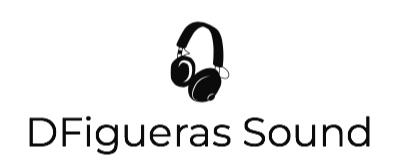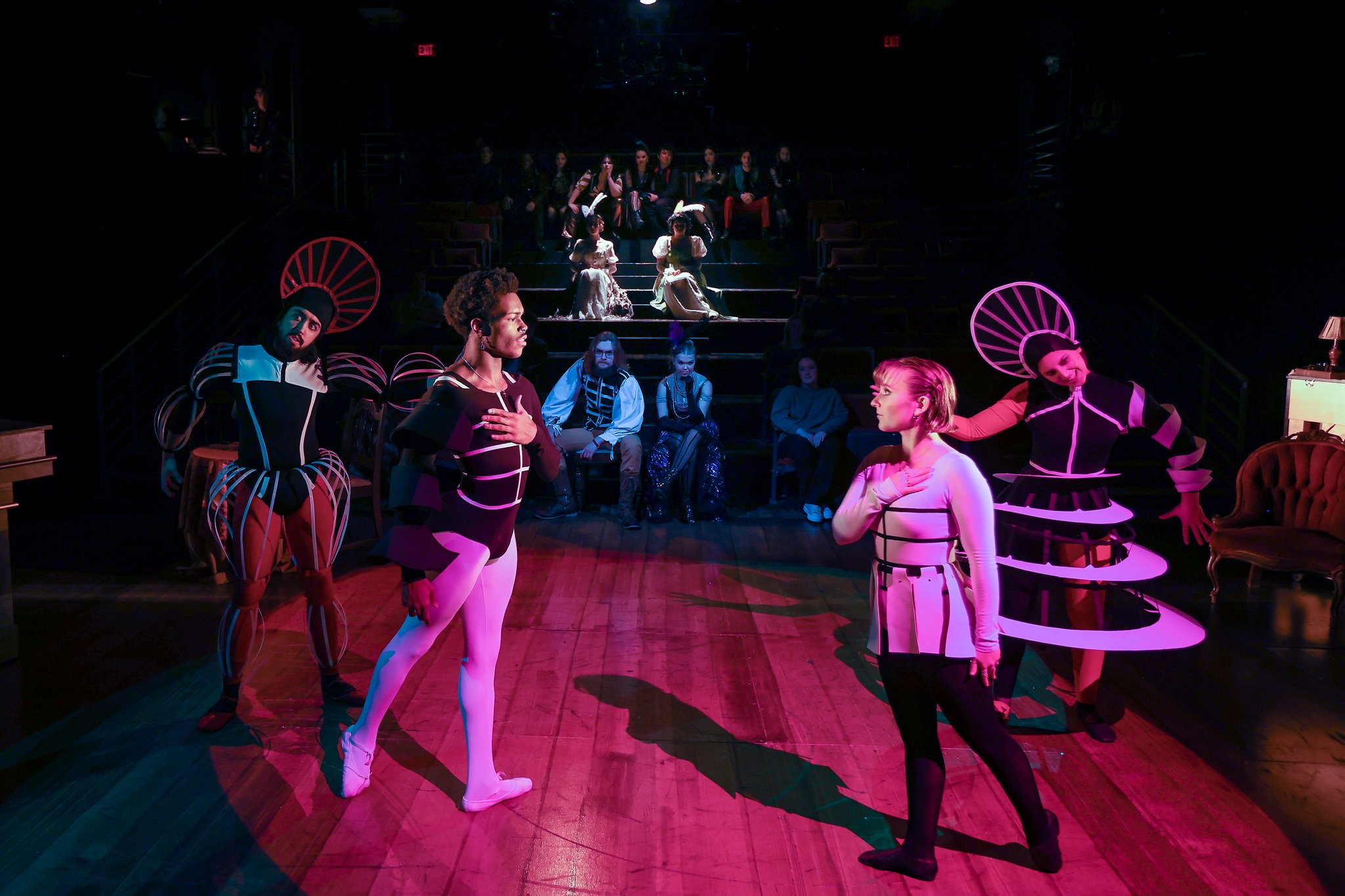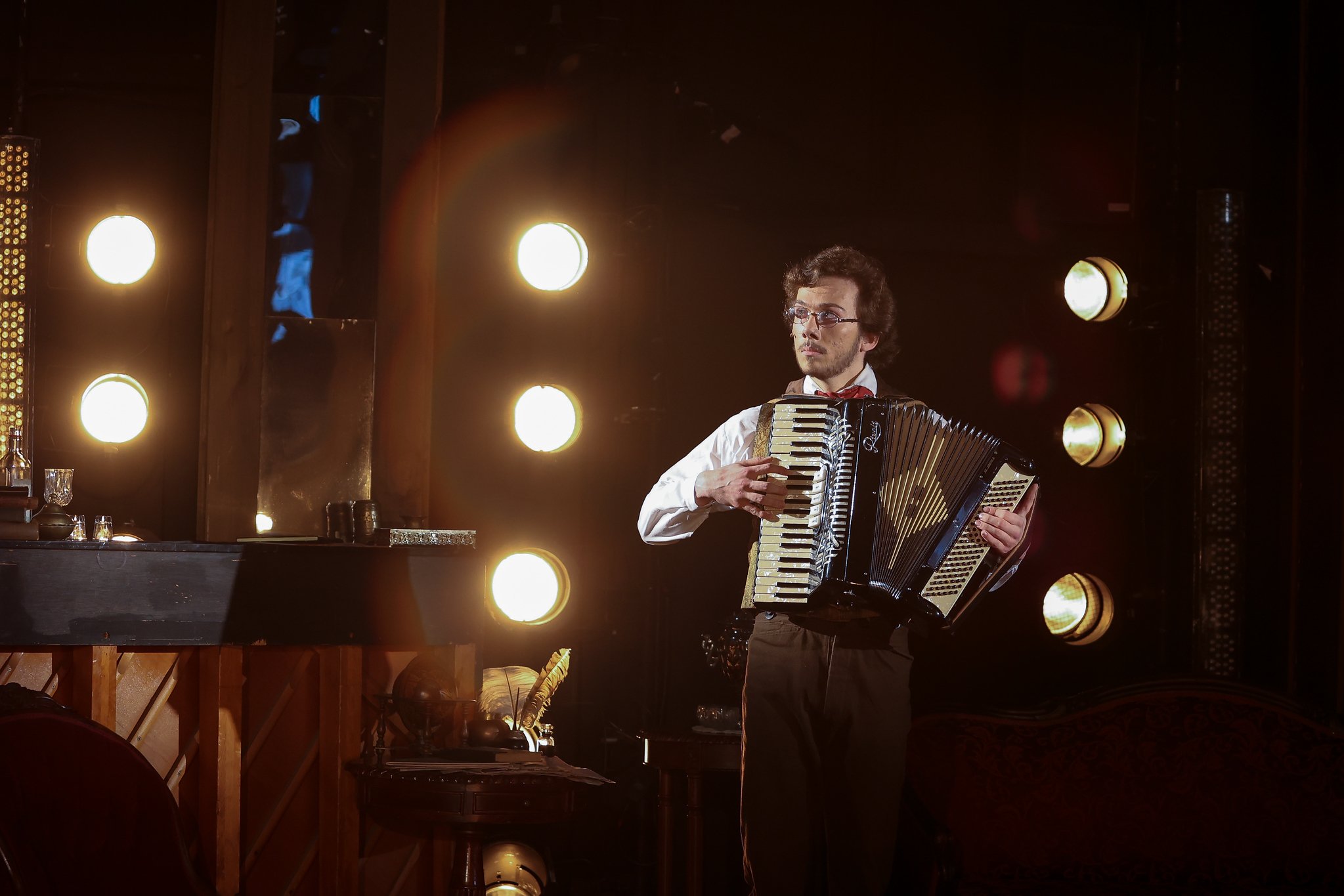NATASHA, PIERRE, and the GREAT COMET OF 1812.
GREAT COMET OF 1812. University of the Arts. 2023
Natasha, Pierre, and the Great Comet of 1812 is a musical adaptation of a small section of Tolstoy’s War and Peace. In this production, the entire theater was utilized as playing space. The goal was to fully immerse the audience in the world of this Russian club. As a designer, this posed a few interesting sound challenges. For starters, this meant there was no separation between audience and performer. So no matter where they were in the room, they had to be able to hear both the actors and the orchestra very clearly. This meant we did away with traditional stage monitors. Every single speaker in the space received both vocals and orchestra. At any given moment, any actor could be directly next to or in front of any speaker in the space. We carefully tuned the system to allow for us to get to the loud level dictated by the score without worrying about feedback. The actors love this because this means they get so much more of their own voice coming back at them then they typically get on musicals.
The next big challenge for us to solve was the placement of the orchestra. With audience members being seated literally everywhere, I was worried that those sitting directly in front of the orchestra would have an uneven mix of band to vocals. To combat this, we did a few clever things! First, we placed the drums in a slightly remote location. The bulk of the orchestra sat on a large platform just behind one side of audience. The drums and keyboard 2 were placed a little further upstairs and removed from the rest of the band. This allowed us to fit the bulk of the musicians on the primary platform but it also allowed us to utilize a drum shield and some sound baffling for the drums without compromising the look of show. Putting Keyboard 2 up there as well allowed us to further hide some of the more modern technology involved in their rig. Aside from the keyboards and some electronic tracks (more on that in a bit!) the rest of the orchestra is acoustic. And boy do they make some beautifully loud sounds in this show! The audience members sitting directly in front of the orchestra weren’t seated in traditional theater seats. Instead, they had these really elegant chairs and there was a table in between them. This proved to be very useful for us! Since they were one level down from the orchestra, we were able to hide a series of speakers just under the orchestra that acted as vocal fills for the folks sitting in the chairs. The placement of the table in between each chair allowed us a clear shot for each speaker to fire right between the two seats. With some delay and EQ, we were able to make them essentially invisible sonically and keep the image on the stage. In my personal opinion, these were the best sounding seats in the house. You got the really great acoustic sound of the orchestra with a bit more punch of vocals!
Some other fun sound stuff on this show: There is a click track for a large portion of the show. This is due, in part, to the fact that there are some electronic drums and sound effects that are part of the score. The orchestration is a beautiful blend of orchestral and electronic. The MD had a QLab session that they triggered throughout the show.
Up until our final dress rehearsal, several members of the orchestra were also meant to play and wander through the theater as well. One was a violin player. He also played the role of Dolokhov. For him, we doubled his input on the console in order to have separate controls and processing over the mic when it was meant for the violin vs when he was just singing. Aside from that, the Clarinet, Oboe and Viola players were also intended to be moving through the space. In addition to the mics we setup for them on the orchestra platform, they each also had a wireless mic for when they moved. While we did end up cutting the roving during our final dress rehearsal, we kept the wireless on them for specific moment we needed them to pop through the orchestra. We had them on some nice DPA mics which sounded fantastic in the solo moments we wanted them to cut through.
With a cast of 20, orchestra of 10, an upright piano onstage (played by Pierre), an accordion (also played by Pierre), a bunch of QLab channels, and some utility God-mics, we ended up utilizing every input and output available to us on the Yamaha QL5 that we had. It wasn’t an easy show but it really was a beautiful production.
Photos by Paola Nogueras.
Great Comet of 1812. University of the Arts. 2023
Direction: Amy Dugas Brown
Music Direction: Kennedy McAllister
Scenic Design: Antonio Ferron
Lighting Design: Thom Weaver
Costume Design: Rebecca Kanach
Sound Design: Damien Figueras



